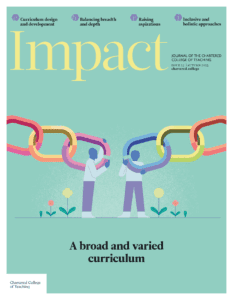Climate change education: A review of some current approaches and opportunities for developing its role in the curriculum

GEMMA GILVIN, DIRECTOR OF LEARNING FOR ENGLISH AND MEDIA, THE JOHN OF GAUNT SCHOOL, UK; EdD STUDENT, UNIVERSITY OF BRISTOL, UK
Climate change will have unpredictable effects for young people and their futures (IPCC, 2023). The government’s Curriculum and Assessment Review (DfEDepartment for Education - a ministerial department responsible for children’s services and education in England, 2025) affords an opportunity for educators to reflect on the purpose and efficacy of climate change education (CCE) through the lens of school curricula. The interim report (DfE, 2025, p. 26) acknowledges the need for students to be adaptable in a changing world, with a ‘greater focus on sustainability and climate science’. This aim builds on recommendations in the Department for Education’s sustainability strategy (DfE, 2022) and their (2023) climate action plans, required for educational settings by September 2025. The importance of CCE is also supported by recent surveys of teachers and secondary school students (Reboot the Future, 2023; Walshe et al., 2024).
This article summarises research considering where CCE is currently situated in the curriculum in England, and where there could be further opportunities to embed CCE in formal school settings. It is beyond the scope of this article to discuss extracurricular opportunities for CCE, such as eco-clubs, litter-picking and Forest Schools, although it should be acknowledged that much effective CCE can take place outside of the formal curriculum.
What could CCE look like in schools?
CCE has a rich and storied history as a subject discipline, emerging from related academic fields including rural studies, environmental education, education for sustainable development and global citizenship education. While there is no established definition for what constitutes CCE, academic literature indicates that there are three main approaches (see, for example, Monroe et al., 2019 and Reid, 2019):
- education about climate change – teaching scientific knowledge and facts about climate change and global warming, its causes and current and possible future impacts
- education for climate change – teaching citizenship skills and how to be more sustainable, focusing on both individual and collective behavioural changes and skills required to participate actively in civic society
- critical and transformative CCE – giving students time to explore their feelings on climate change, thereby creating conditions to respond to an uncertain future; or processing climate anxiety and climate hope through creative and participatory methods such as artwork, storytelling and drama.
Internationally, approaches to CCE are more commonly focused on cultivating scientific knowledge and education about climate change (Dawson et al., 2022). In England, the current provision for CCE in the National Curriculum focuses solely on learning about the science of climate change in the science and geography curricula, first introduced explicitly in Key Stage 3 (Howard-Jones et al., 2021).
For Stevenson et al. (2017, p. 70), there is greater emphasis on ‘climate’ than ‘change’ in many educational approaches. Recent research argues that there is value in expanding our conceptualisation of CCE beyond purely scientific understanding, and especially educating about collective responses to the climate crises (Rousell and Cutter-Mackenzie-Knowles, 2020). This is also reflected in the vision for the DfE’s sustainability strategy (2022), which states that ‘learners need to know the truth about climate change – through knowledge-rich education. They must also be given the hope that they can be agents of change, through hands-on activity and, as they progress, through guidance and programmes allowing them to pursue a green career pathway in their chosen field.’
This reconfiguration of CCE, from an exclusively knowledge-based approach to a more multifaceted approach, could help CCE to remain relevant and adaptable for an uncertain future.
Critiquing CCE
At a theoretical level, approaches to CCE that focus on cultivating behavioural changes and action are inherently value-laden – questions around whose values are being presented and for what purpose are important for educators to consider, especially when driven by concerns about equity and social justice (Trott et al., 2023). This is challenging when considering the politics of climate change, particularly within the context of political impartiality in schools (Dunlop and Rushton, 2022). National initiatives intersect with international political attention too, with education for sustainable development included in the UN’s (2015) Sustainable Development Goals for 2030.
More practically, schools face decisions around where to prioritise curriculum time and resources, including teacher training and professional development. With many schools, especially secondary, organised into subject-based models, it can be difficult for a teacher or subject team to assume responsibility for CCE, among competing demands for curricular and extracurricular space. Rushton et al. (2023) note that this has been particularly challenging when CCE has had low representation in educational policymaking in England. The DfE’s (2023) requirement that schools publish a holistic climate action plan by September 2025 provides hope that school leaders will be encouraged to map teaching and learning about sustainability coherently across the curriculum, including further training and networking opportunities for staff.
Where does CCE ‘fit’ in the curriculum?
Eilam (2022) advocates for the creation of CCE as a separate subject within the curriculum, suggesting that this approach would develop and deepen an existing body of content knowledge and skills. This would afford CCE protected curricular time, with assessment programmes, training and resources for teachers. The incoming natural history GCSE furthers this possibility for secondary educators, with its proposed content focusing on knowledge of the natural world and active conservation, which could serve as an opportunity to extend CCE in the formal curriculum beyond purely scientific understanding.
Alternatively, CCE could be suffused throughout the formal curriculum. Greer et al.’s (2023) survey of teachers in England revealed that more than half of respondents wanted sustainability and climate change to be formally recognised in the National Curriculum content for their subject. In an earlier study, Howard-Jones et al. (2021) concluded that most teachers surveyed favoured an action-oriented curriculum, taught across multiple curriculum subjects. Recently, the Royal Meteorological Society (2025) published a curriculum for climate literacy that supports a multi-curricular approach to CCE, providing a practical framework for where CCE can be embedded in school curricula across a range of subjects. The government’s National Education Nature Park (www.educationnaturepark.org.uk) also provides teaching and learning resources organised by key stage and subject area, recognising that climate change and sustainability need not only be reserved for science and geography teachers (who still have a crucial part to play). Arts-based and creative methods for exploring student responses to climate change could complement the scientific understanding already specified in the National Curriculum, for example. A multi-curricular approach would allow for a plurality of perspectives, reflecting the complexity of climate change (Morrisey Gleeson and Morrisey, 2024).
In light of the DfE’s sustainability strategy (2022) and the publication of the DfE’s interim Curriculum and Assessment Review (2025), schools have both a requirement and an opportunity to critically reflect and act on their provision for CCE. This might include: organising professional development on sustainability; involving and empowering students, parents and community stakeholders to contribute to the school’s climate action plans; providing meeting time for subject leaders to collaboratively map where their subject curriculum content could incorporate CCE; encouraging teaching staff and school leaders to create professional networks to share best practice; promoting a whole-setting approach to CCE that recognises and values a plurality of methods; or developing open forums where issues on sustainability and climate change in the curriculum can be openly communicated and discussed among the staff body. There is a wealth of good practice published by subject associations, charities and in the DfE’s climate action plan literature.
Conclusion
As teachers, we are preparing students to be resilient in the face of uncertain futures. CCE remains contested, complex and changing at pace to reflect this reality. The DfE’s Curriculum and Assessment Review marks a pertinent point for reflection, especially when considered in conjunction with the DfE’s sustainability strategies (2022) and the climate action plans (2023) required for educational settings in September 2025. This invites important questions: which approaches to CCE are most needed and most effective? What curricular time might be afforded, and within or outside of which subjects? How can teachers receive funding and resources in these areas? It also represents exciting opportunities: to build responsive curricula and pedagogies for CCE, to answer calls for a broadening of CCE with greater curricular attention, and to consider teacher and student voices in how we reimagine education for the future.
- Dawson V, Eilam E, Tolppanen S et al. (2022) A cross-country comparison of climate change in middle school science and geography curricula. International Journal of Science Education 44(9): 1379–1398.
- Department for Education (DfE) (2022) Sustainability and climate change strategy. Available at: www.gov.uk/government/publications/sustainability-and-climate-change-strategy (accessed 21 June 2025).
- Department for Education (DfE) (2023) Sustainability leadership and climate action plans in education. Available at: www.gov.uk/guidance/sustainability-leadership-and-climate-action-plans-in-education (accessed 21 June 2025).
- Department for Education (DfE) (2025) Curriculum and Assessment Review: Interim report. Available at: https://assets.publishing.service.gov.uk/media/67e6b43596745eff958ca022/Curriculum_and_Assessment_Review_interim_report.pdf (accessed 15 April 2025).
- Dunlop L and Rushton EAC (2022) Putting climate change at the heart of education: Is England’s strategy a placebo for policy? British Educational Research Journal 48: 1083–1101.
- Eilam E (2022) Climate change education: The problem with walking away from disciplines. Studies in Science Education 58(2): 231–264.
- Greer K, Sheldrake R, Rushton E et al. (2023) Teaching climate change and sustainability: A survey of teachers in England. University College London. Available at: https://discovery.ucl.ac.uk/id/eprint/10173208/1/Teaching%20climate%20change%20and%20sustainability_CCCSE%20survey_July%202023.pdf (accessed 28 June 2025).
- Howard-Jones P, Sands D, Dillon J et al. (2021) The views of teachers on an action-oriented climate change curriculum. Environmental Education Research 27(11): 1660–1680.
- Intergovernmental Panel for Climate Change (IPCC) (2023) Climate change 2023: Synthesis report: Summary for policymakers. Available at: www.ipcc.ch/report/ar6/syr/downloads/report/IPCC_AR6_SYR_SPM.pdf (accessed 28 June 2025).
- Monroe M, Plate R, Oxarart A et al. (2019) Identifying effective climate change education strategies: A systematic review of the research. Environmental Education Research 25(6): 791–812.
- Morrissey Gleeson E and Morrissey J (2024) Towards a fit-for-purpose climate change education: A systematic literature review identifying core principles and potential barriers. Environmental Education Research. DOI: 10.1080/13504622.2024.2416549.
- Reboot the Future (2023) The Rebooting Education report 2023. Cambridge University Press and Assessment. Available at: www.rebootthefuture.org/media/Rebooting-Education-Report-2023-9MB.pdf (accessed 15 April 2025).
- Reid A (2019) Climate change education and research: Possibilities and potentials versus problems and perils? Environmental Education Research 25(6): 767–790.
- Rousell D and Cutter-Mackenzie-Knowles A (2020) A systematic review of climate change education: Giving children and young people a ‘voice’ and a ‘hand’ in redressing climate change. Children’s Geographies 18(2): 191–208.
- Royal Meteorological Society (2025) A curriculum for climate literacy. Available at: www.metlink.org/wp-content/uploads/2025/06/A-Curriculum-for-Climate-Literacy.pdf (accessed 21 June 2025).
- Rushton E, Sharp S, Kitson A et al. (2023) Reflecting on climate change education priorities in secondary schools in England: Moving beyond learning about climate change to the emotions of living with climate change. Sustainability 15(8): 6497.
- Stevenson RB, Nicholls J and Whitehouse H (2017) What is climate change education? Curriculum Perspectives 37(1): 67–71.
- Trott CD, Lam S, Roncker J et al. (2023) Justice in climate change education: A systematic review. Environmental Education Research 29(11): 1535–1572.
- United Nations (UN) (2015) 4: Quality education. The Global Goals. Available at: www.globalgoals.org/goals/4-quality-education (accessed 15 April 2025).
- Walshe N, Sheldrake R, Healy G et al. (2024) Climate change and sustainability education: A survey of students in England. University College London. Available at: https://discovery.ucl.ac.uk/id/eprint/10195286/1/UCL%20Student%20Survey%20Report.pdf (accessed 28 June 2025).










